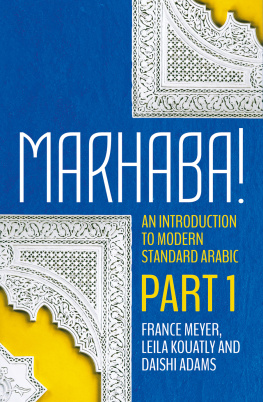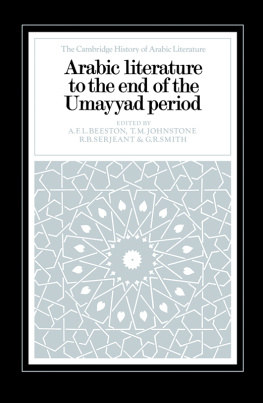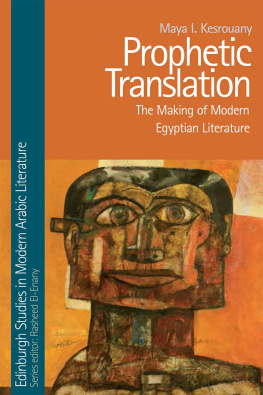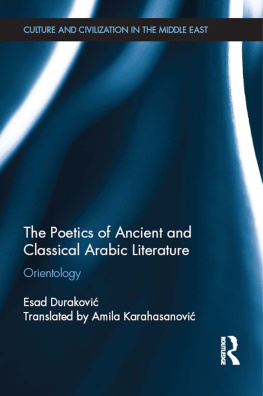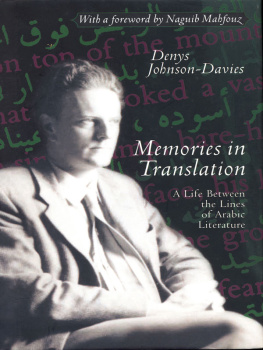A BRIEF INTRODUCTION TO
MODERN ARABIC LITERATURE
DAVID TRESILIAN
SAQI
London San Francisco Beirut
eISBN: 978-0-86356-802-2
First published by Saqi, 2008
This eBook edition published 2012
Copyright David Tresilian
All rights reserved. No part of this book may be reproduced or transmitted in any form or by any means, electronic or mechanical, including photocopying, recording or by any information storage and retrieval system, without permission in writing from the publisher.
This book is sold subject to the condition that it shall not, by way of trade or otherwise, be lent, re-sold, hired out, or otherwise circulated without the publishers prior consent in any form of binding or cover other than that in which it is published and without a similar condition including this condition being imposed on the subsequent purchaser.
A full CIP record for this book is available from the British Library.
A full CIP record for this book is available from the Library of Congress.
SAQI
26 Westbourne Grove, London W2 5RH
www.saqibooks.com
Contents
Illustrations
9. A still from the film The Sin by Yusif Idris
Courtesy of Culture Development Fund, Ministry of Culture, Egypt
10. An extract from Song of the Rain by Badr Shakir al-Sayyab
Courtesy of Dar al-Awdat, 1989
Acknowledgements
I would like to thank Lawrence Joffe for suggesting this book to me and everyone at Saqi, especially Rebecca OConnor, for tracking down the pictures and seeing it through the press. The enthusiasm and support of the late Mai Ghoussoub were great sources of encouragement when the book was first discussed. Finally, I am grateful to friends in Paris and Cairo, particularly Asmahan El-Batraoui and Mona Anis, for comments and suggestions that saved me from several false steps.
Introduction
English-speaking readers interested in modern Arabic literature have sometimes not been well served. While more works translated from the Arabic are now available in English than was the case even a few years ago, it is still possible to walk into an ordinary bookstore and find few, if any, works by Arab authors on the shelves. Under such circumstances writing a brief introduction to modern Arabic literature is likely to be a particular challenge. Having been introduced to this literature, how likely is it that readers will be able to explore it for themselves?
Fortunately, the situation is not as bad as it can sometimes seem, and recent years have seen growing interest in literary translation from the Arabic. High-quality translations of the works of many Arab authors are available today, not least those of the winner of the 1988 Nobel Prize for Literature, the late Egyptian novelist Naguib Mahfouz. Even so, in general it still remains the case that Arabic literature is often not well known outside the Arab world, much of the literature produced in the twenty-two countries making up the Arab League, extending, as a phrase used by the Arabs has it, from

1. Map of the Arab world showing the major literary centres of Cairo, Beirut and Baghdad
This book will argue that this situation is a pity for various reasons. First, there is the obvious loss that it entails for western readers. The Arab world is one of Europes closest neighbours, and, occupying the whole of the southern and eastern Mediterranean and stretching to the borders of Iran, it is not as far away from us as we might sometimes be encouraged to think. It would be a shame if this regions cultural achievements and debates, as represented in its modern literature, were to remain a closed book to us as a result of translations that are either few in number or that are not widely accessible.
However, even more than by this fact of geographical proximity, modern Arabic literature is already connected with us in a sense that it is hoped this book will go some way towards making plain. Not only does modern Arabic literature refer to some of the same modern history, though seen from the other side the history of colonization, for example, or of the effects of western involvement in non-western societies but it has for at least some of the time looked towards European models for inspiration. For those with a theoretical turn of mind, modern Arabic literature provides intriguing material for reflection along lines suggested by fields such as postcolonial studies, translation studies and the emerging study of world literature. Reading it may not only help us to learn about a different set of societies and a different culture from our own, but may also help us to see our own society and culture in a different light.
The aim of this book is first and foremost to suggest some ways in which modern Arabic literature might be thought about, both for the general reader interested to know a little about this literature and for students, not primarily Arabists, engaged in comparative literary study. There are various ways in which the title may be taken. This is a brief introduction to modern Arabic literature, and brevity has entailed a considerable degree of compression, though it is hoped that this has not come at the price of too much distortion. Though coverage has had to be sacrificed in order to ensure manageable length, it is hoped that not too much has been left out and not too many authors have gone unmentioned. In terms of scope, for the purposes of this book modern Arabic literature means material written since 1945, the emphasis being placed on recent decades and on prose fiction. However, it is not possible to understand this material without a sense of the historical background, so material written earlier in the century is surveyed, as is all too briefly modern Arabic poetry and drama.
Modern Arabic literature, for the purposes of this introduction, also
A further point is that while this book aims to discuss literature produced across the Arab world without emphasizing any one national literature, the literary production of modern Egypt is given greater space than that of other countries. There are good reasons for this. Egypt is the largest and oldest of the modern Arab states, and it possesses what has historically been the most influential literary and intellectual milieu. This situation is encapsulated in a phrase sometimes used by the Arabs to the effect that Cairo writes, Beirut publishes and Baghdad reads, which reflects a long-standing division of intellectual labour within the Arab world. While this situation may be changing, the Iraqi reading public having been decimated by events in that country, and the Beirut publishing industry arguably not having recovered from Lebanons long civil war, it is still the case that the Cairo literary scene has the longest history and the greatest prestige, even though Egypt may be losing its traditional position of intellectual leadership in the Arab world.

2. Informal bookselling, such as in Cairo, can help overcome perennial problems of distributing books in the Arab world
Egyptian intellectuals dominate Arab universities and the Arab media, whether published in Cairo or elsewhere, and the autobiographies of writers and intellectuals from other Arab countries often talk of their authors having had an Egyptian teacher of Arabic at school, or of growing up reading Egyptian literature, watching Egyptian films or listening to Egyptian music.


